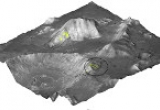A complex magmatic history for Mars
20/11/2013 - 00:00
Mars is a volcanic world, covered nearly entirely in basaltic rocks. While the planet's geological history remains elusive for lack of in-situ samples or probes of its internal structure, its uniform surface composition was thought to result from an unremarkable magmatic history. However, this is questioned by a recent study lead by ESO and IAS, which has revealed a new rock type on Mars.
This rock type is akin to anorthosite, which is made of plagioclase feldspar (90–100%), and a minimal mafic component (0–10%). Previously only known to be associated with the lunar highlands and with peculiar magmatic formations on Earth, the presence of anorthosite on Mars demonstrates that the planet experienced a more complex magmatic history than previously thought, and provides unique opportunities to investigate early crustal formation mechanisms on a planetary body other than Earth.
These discoveries where made possible thanks to the NASA Mars Reconnaissance Orbiter and ESA Mars Express missions, including the CRISM and OMEGA infrared spectrometers.
Reference : Carter J. and F. Poulet, Ancient plutonic processes on Mars inferred from the detection of possible anorthositic terrains, Nature Geo. This article is also the subject of a News & Views comment of Nature Geoscience
Link: http://www.abc.net.au/science/articles/2013/11/18/3891945.htm

This image shows the location of anorthositic terrains detected from orbit over an ancient butte (to the south) and a degraded crater rim (to the north) of the highland region of Mars. The topographic image is built using data from the ESA HRSC instrument onboard Mars Express, while the anorthositic terrains are mapped in green using two observations from the NASA CRISM instrument onboard MRO.




